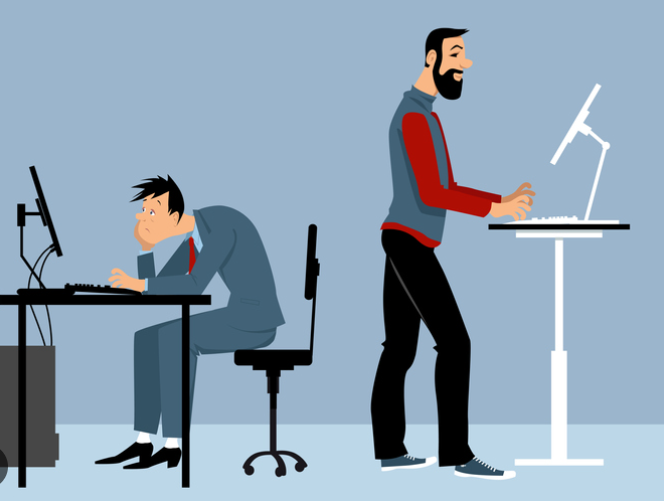Evaluating the efficiency and back health implications of working postures, particularly sitting versus standing, sheds light on a pivotal aspect of modern work environments. As occupational dynamics evolve, understanding the benefits and drawbacks of these positions is crucial. This analysis compares ergonomics, productivity, and health impacts of sitting versus standing desks, guiding towards an informed choice.
Rise Up: Standing Desks Redefining Healthy Workspaces Amidst the Sedentary Struggle
The concept of a standing desk has gained traction, fueled by studies highlighting the drawbacks of prolonged sitting. Sedentary lifestyles contribute to health issues such as cardiovascular diseases and obesity. Transitioning to a standing position during work hours introduces movement, combating the sedentary menace. Research indicates standing promotes calorie burn, energizes the body, and may enhance focus and productivity. However, it’s not without cons.
Standing for extended periods can lead to discomfort and foot pain, underscoring the need for balance and the integration of anti-fatigue mats. Critics argue that the sudden shift may not suit everyone, especially those with pre-existing musculoskeletal problems. Despite these challenges, the standing desk emerges as a viable alternative, aiming to mitigate the health risks associated with sedentary work habits while possibly boosting work efficiency.
Sit-Down Work: Comfort Versus Consequences
Comfort often accompanies the traditional sitting workstation, with its familiar setup fostering a sense of ease during tasks. Chairs and desks designed for long hours of use promise support and convenience. Yet, the comfort comes with hidden costs. Extensive periods spent seated can lead to a myriad of health concerns, including increased risk for type 2 diabetes, heart disease, and chronic back pain, attributed to poor posture and lack of movement.
The human body craves activity, and the static nature of seated work contradicts this fundamental need. While ergonomic chairs and accessories attempt to mitigate these issues, they cannot fully counteract the inherent risks of prolonged sitting.
Transition to Standing: A Balanced Approach
Adopting a standing workstation signifies a commitment to health and productivity, yet requires careful consideration to maximize benefits. Gradual introduction is key, allowing the body to adjust to new dynamics. Experts recommend starting with short intervals of standing, gradually increasing duration as comfort levels improve.
It’s crucial to invest in quality equipment, such as adjustable desks and ergonomic floor mats, to ensure proper posture and reduce strain. Balancing standing with periods of sitting prevents fatigue, offering a hybrid model that caters to both health and efficiency. The transition also opens opportunities for subtle physical activities, like stretching or foot tapping, enriching the workday with movement.
Ergonomic Optimization at the Standing Workstation
Optimizing the standing workstation involves more than adjusting height; it’s about creating an environment conducive to well-being and productivity. Correct desk height aligns with elbows at a 90-degree angle, ensuring comfortable typing and viewing angles. Screen placement is critical, with the top of the monitor at or slightly below eye level to prevent neck strain.
Anti-fatigue mats offer cushioning, encouraging subtle movements and reducing leg stress. Additionally, incorporating regular breaks and stretching routines enhances circulation and muscle flexibility. Organizational tools, such as cable management systems and monitor arms, maintain a clutter-free space, promoting focus and mental clarity.
Mastering Workspace Organization at a Standing Desk
Efficient workspace organization transcends aesthetics, impacting functionality and focus at a standing desk. Cable management systems are indispensable, eliminating hazards and maintaining a clean visual field. Accessories like under-desk hooks and organizers keep essentials within reach without cluttering the work surface. Adjustable monitor arms offer flexibility, catering to different tasks and postures, while vertical storage solutions maximize space and accessibility. Personalizing the workspace with plants or motivational items can enhance mood and productivity.
Streamlining Efficiency: Organization Tips for the Time-Conscious Standing Desk User
Efficiency at a standing desk is paramount, particularly for those keen on maximizing productivity within limited time frames. Adopting a digital-first approach declutters the workspace, leveraging cloud storage and digital tools for document management. Utilizing vertical space with shelves and wall-mounted organizers keeps essential tools within arm’s reach yet off the work surface. Labeling drawers and storage compartments simplifies the search for supplies, saving precious minutes. Incorporating a small, easily accessible filing system on or near the desk ensures important documents are handy without overwhelming the space.
Desk accessories, such as pen holders and sticky note trays, should be minimalist, occupying minimal space while keeping necessities organized. A magnetic board or corkboard can visually display tasks and reminders, making them easy to update and track. Regularly scheduling decluttering sessions prevents accumulation of unnecessary items, maintaining an environment conducive to focused work. Personal items should be selective, adding a touch of inspiration without causing distraction.
Finding the Ideal Height and Setup for Your Standing Desk
Identifying the perfect height and setup for a standing desk is paramount for comfort and productivity. The ideal desk height allows for a relaxed shoulder position, with arms resting comfortably at a 90-degree angle. Monitors should be positioned to avoid tilting the head forward, reducing the risk of neck strain.
Incorporating adjustable features facilitates transitions between standing and sitting, accommodating varying tasks and comfort needs throughout the day. Personalizing the workstation with ergonomic accessories, like keyboard trays and document holders, enhances functionality and comfort.
Optimal Placement of Standing Desks: Harnessing Natural Light
Natural light plays a pivotal role in creating an ideal workspace, especially when positioning a standing desk. Placing the desk near a window offers access to sunlight, uplifting mood and enhancing focus. However, direct sunlight on screens can cause glare, straining the eyes. To circumvent this, orient the desk parallel to the window, ensuring light flows from the side. This setup minimizes glare while providing sufficient natural light for tasks. Adjustable blinds or curtains become invaluable, allowing control over light intensity and reducing eye fatigue.
Monitors should face away from direct light sources to prevent reflections that can obscure screen visibility. An anti-glare screen protector offers an additional layer of defense against harsh lighting conditions. Ergonomic lighting solutions, such as desk lamps with adjustable brightness, complement natural light, filling in during overcast days or evenings. The goal is to achieve a harmonious balance of natural and artificial light, preventing shadows and reducing the need for excessive screen brightness, which can tire the eyes.


